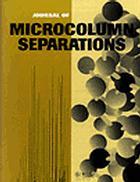|
Literature / Source Database:
Journal of Microcolumn Separations
Description
since 01/2002 merged with J. Sep. Sci.
| Title (short) |
J. Microcolumn Sep. |
| Languages |
English |
| First year |
1989 |
| Last year |
2001 |
| Editor |
Milton L. Lee, Pat Sandra |
|
|

|
Status
merged with
Indexing
Analytical Abstracts, Biological Abstracts/BIOSIS,
Chemical Abstracts, Chemistry Citation Index, Chromatography Abstracts, Current Abstracts of Chemistry (ISI, Current Contents/Physical, Chemical & Earth Sciences, Engineering Index,
Research Alert
Successor
Subject

Source type
Journal
Publisher
ISBN ISSN
1040-7685
First volume
8
Last volume
13
Homepage
| Resources |
|
Availability |
|
|
|
|
|
| Text PDF |
 |
free access |
 |
| Text Html |
 |
for subscriber |
 |
| References |
 |
not available |
 |
| Abstracts |
 |
|
|
| TOC |
 |
|
|
|
|
|
|

Description
The Journal of Microcolumn Separations is a bimonthly, international publication established to present original fundamental and applied research concerning all aspects of microcolumn separation methods, including microcolumn liquid chromatography, capillary electrophoresis, microcolumn supercritical fluid chromatography, capillary gas chromatography, and other related microcolumn techniques. Coupled systems and ancillary techniques, particularly in the area of detection, are within the scope of the journal. Analytical extraction and sample preparation techniques, such as supercritical fluid extraction, solid phase extraction, membrane sampling, and other micro-extraction techniques, are also included because of their importance as an integral part of the total analysis. Issues contain scholarly research papers, short communications or notes, and timely reviews.
The Journal of Microcolumn Separations is unique among other journals in that the focus is restricted to microcolumn separation techniques. Other established chromatography journals emphasize gas chromatography or liquid chromatography, while this journal emphasizes the miniaturization of all chromatographies and electrically-driven separation techniques. The title and scope of the journal have been designed to accommodate variation of these established microcolumn methods as well as new microcolumn separation methods that are on the horizon. Current trends predict that the most exciting future developments in separation science will be in the areas involving miniaturized systems.
Related links:
|